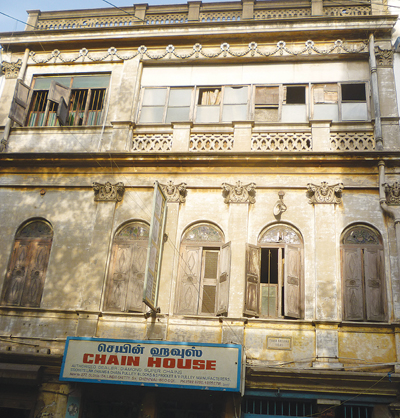
|
 |
Old buildings of Triplicane |
The recent collapse of an old building in Triplicane, resulting in the death of two, was tragic news indeed. With the monsoon just around the corner, there is considerable speculation as to how many more such collapses will be witnessed.
The Corporation has begun a survey of such structures in the older parts of the city. The general opinion, formed even before the survey, is that old buildings are necessarily culprits and demolition to make way for new structures is the only option. What is forgotten is that the weakening of such structures is not the disease but a symptom of something much deeper – the ad hoc and uncontrolled way in which building activity is happening in our neighbourhoods, coupled with complete lack of awareness as to how to deal with old buildings.
The building that collapsed was undergoing renovation. The Corporation, as reported in the newspapers, has stated that it had no idea that such renovation was going on. A wall was being altered and that is widely believed to have caused the fall. As the building is more than 40 years old, it does not come under the Chennai City Municipal Corporation Act, at least as far as its structural stability is concerned. The CMDA does not take into cognisance buildings constructed before 1973. Therefore, buildings such as the one that fell are open to any kind of change and alteration, as long as they don't encroach upon the public space.
Most of these buildings are of the street-house variety, sharing common walls with their neighbours. They were constructed at a time when a sense of shared well-being was the norm. All that changed with the owners of some of these structures beginning to entertain thoughts of raising multi-storied buildings on the same space. That put the surrounding buildings under stress. Apart from the vibrations resulting from pile foundations, highrises cut off ventilation to the neighbouring buildings causing dampness, which further weakens the older structures.
There is also the problem of indiscriminate addition of floors to an existing structure, often without any proper study on the load-bearing members. Even in the case of the building that collapsed, there is considerable speculation on whether the first floor was built with any kind of approval. And given the present crop of architects, masons and contractors, it would be no exaggeration to state that there is complete ignorance as to how to go about handling buildings of some vintage. Comfort with concrete and glass is the order of the day and, therefore, there is very little scope for protecting old buildings.
Lastly, there is the mammoth issue of illegal construction. It is reported that there are 1.7 lakh illegal structures in the city today, all merrily cocking a snook at building rules and safety requirements. When the administration chooses to turn a blind eye towards these violations, how can it expect collapses not to take place? It needs to be firm at the stage of construction and nip in the bud any attempt at violating laws at that stage itself. There is no point in lamenting about it after the malaise has been allowed to flourish.
What is needed now is a set of positive steps if older buildings are to survive. The Corporation or the CMDA must begin educating property owners on the benefits of older buildings and that they offer an alternative way of life that is also to the good. Secondly, the Corporation needs to have a cell that specialises in restoration and renovation of old buildings. Currently such a facility does not exist. This unit must be able to advise owners of old buildings on how structural safety can be ensured. It must also keep a watch on renovations and repairs that go on in old buildings. Lastly, the Corporation and the CMDA need to become proactive on illegal construction activity.
If these steps are adopted, we can see less of haphazard construction on, in or in place of old buildings. And that will mean less collapses and avoidable human loss.
|